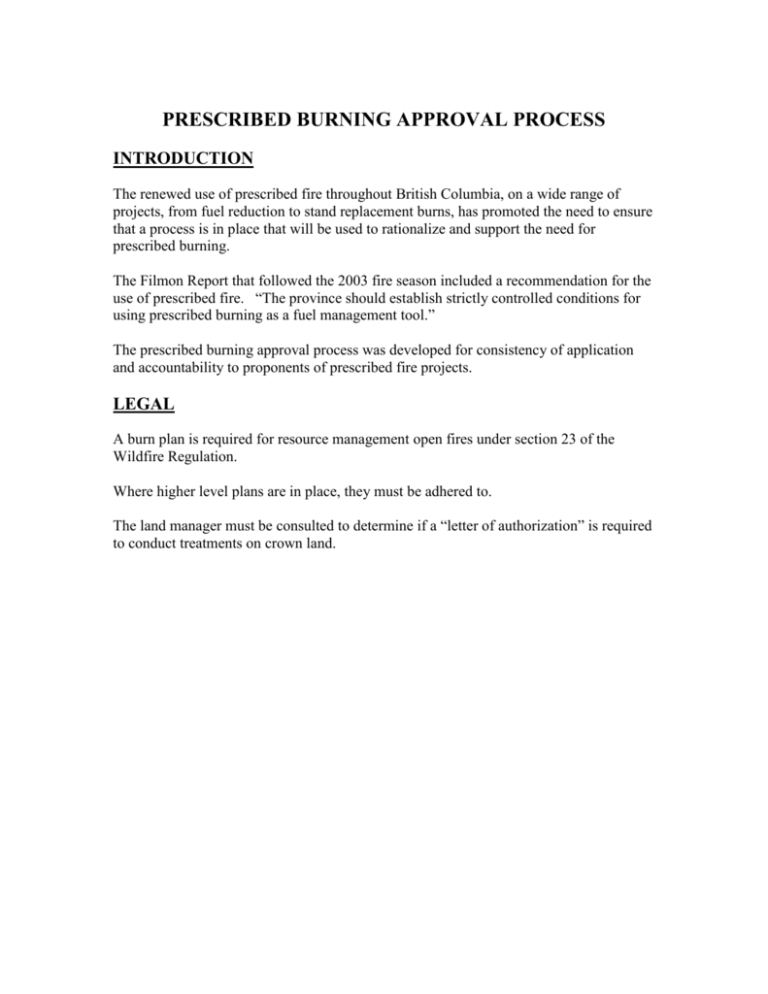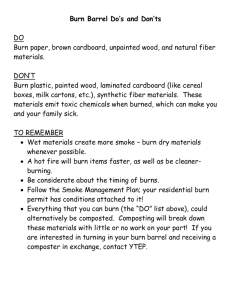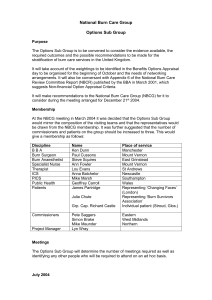prescribed burning approval process for non
advertisement

PRESCRIBED BURNING APPROVAL PROCESS INTRODUCTION The renewed use of prescribed fire throughout British Columbia, on a wide range of projects, from fuel reduction to stand replacement burns, has promoted the need to ensure that a process is in place that will be used to rationalize and support the need for prescribed burning. The Filmon Report that followed the 2003 fire season included a recommendation for the use of prescribed fire. “The province should establish strictly controlled conditions for using prescribed burning as a fuel management tool.” The prescribed burning approval process was developed for consistency of application and accountability to proponents of prescribed fire projects. LEGAL A burn plan is required for resource management open fires under section 23 of the Wildfire Regulation. Where higher level plans are in place, they must be adhered to. The land manager must be consulted to determine if a “letter of authorization” is required to conduct treatments on crown land. FLOW CHART The flow chart is intended to reflect the step by step process that must be completed as part of the Prescribed Fire Approval Process. This process will be utilized for audit and investigation purpose as and when required. PREPLANNING INFORMATION High Level Plans; The majority of prescribed burns should be recommended from Higher Level. The intent of Cabinet or policy approved High Level Plans (Land Resource Management Plans (LRMP) including Resource Management Zones (RMZ), or similar designation, Landscape Unit Plans) must be followed. These plans direct the need for and the use of prescribed fire. Operational Operational Plans such as a Range Use Plans are also legal sources of identified needs. Though not considered operational plans by definition, five year burn plans for agencies such as Ministry of Environment (Wildlife Branch), and B.C. Forest Service (Range Department) should be considered for sources of information. It is recommended that proponents and clients put forth proposals through these appropriate agencies. In this way prescribed burn projects can be prioritized for approval, resource allocation, and inclusion with the overall management objectives for an area. Referral Input The referral input allows identified key stakeholders, and the public an opportunity to have input to a project at a preliminary stage prior to commitment of resources. This step is particularly valuable when presenting a five year plan or an update to an existing plan. It is also an opportunity to consider the full range of alternatives available to meet a given objective in addition to prescribed fire. In addition, input from other planning groups or specialist can be taken into consideration for example Region NDT-4 Committee. A joint field trip can be conducted to deal with project area issues and concerns, or area identification. Stakeholder Committee The stakeholder committee (various titles can be used) is a forum used for a group of representatives, within a management area, for example eg District or Protection Zone, that meet to discuss and communicate matters of common interest and concern. Communication is the main catalyst of this group. It is a recommended step as it allows proponents and various stakeholders to share information. The selection of the representatives for each group (eg ranchers) should be left with the appropriate program (B.C. Forest Service Range Program). The terms of reference for the stakeholders committee can be developed to meet the specific needs. PLANNING Objectives must be clearly defined. An important component of the burn plan development is the liaison with a Protection Specialist. The Protection Specialist can assist in developing meaningful measurable objectives specific to the project area, that link with the overall objective. In addition the logistics, timing, and layout of the project can be dealt with at an early stage and reflected in the Burn Plan. Submit Burn Plan The Burn Plan is submitted to the appropriate Protection Office for review and approval as per Section 23 of the Wildfire Regulation. The Burn Plan is to include the completed Complexity Rating for the proposed project. Peer Review A peer review by a qualified person(s) should be undertaken, prior to submission, to ensure the person completing and signing the burn plan is qualified and authorized. This step also provides an independent analysis of the proposed objectives versus indicated burn plan activities. Burn Plan Approval The approval of the burn plan should also include a peer review when the individual is not fully qualified, in training, or when the plan exceeds their level of certification. PROJECT Implementation The Burn Plan for the project requires specific actions to be completed prior, during, and after the project is completed. Critical activities of the Burn Plan include; Public Information - An aggressive public information plan should be implemented for every burn project. The scope of the plan will depend on the specific project location and local issues. Ensuring local residents are kept informed of all developments is key to the success of the project and continuation of the program. “Go No Go” - This is a decision aid developed to ensure all components have been dealt with. If any of the action items are negative then the burn should not proceed until remedied (Schedule 11 attached). Project Test Burn - A representative site within the project is selected to carry out a test burn. The purpose of the test burn is to ensure conditions are present to meet the objectives and meet the fire control requirements specified in the Burn Plan. Documentation of the test burn will be included with the project file and final report. Documentation - Accurate and complete documentation of all stages of a prescribed burn project is integral to the project itself. The documentation serves as a record of compliance to the Prescribed burn approval process, burn plan, and implementation actions. It further provides the basis from which to evaluate the project for success and improvements and an audit trail if required. The use of digital photos provides excellent reference information for before, during, and post burn actions and conditions. Post Burn At the conclusion of the project a final report should be completed including map(s). It is recommended this be carried out within two weeks of project completion. The final report should contain sufficient information to provide an update to the history data base, input and update the forest cover and Inventory systems and maps, and provide documentation of the results of the project relative to the objectives. The information should be stored on the B.C. Forest Service Opening files, as well as the project file for future access and reference. A project review or debriefing should be a regular component of the post burn events. This allows for improvements on future projects as well as closure to those stakeholders and the public that were involved in the project. POST Monitoring Monitoring of a project could include a formal research program, local operational monitoring, or a combination of both. Specified standards should be developed and followed on those projects selected to ensure meaningful use of the data collected. A research monitoring plan should select representative sites to maximize results as well as recognize limitations of resources and funds. Operational monitoring should be clear in the results being measured and the intended use. Consideration should be taken to prevent duplication of information where it already exists. Review and Documentation A formal review should be carried out on selected projects by B.C. Forest Service staff. This review would ensure adherence to procedures and provide credibility of the use of prescribed fire for the public and stakeholders. Results should be broadly circulated to all participants both within and outside Government. Revised 2005-09-29






